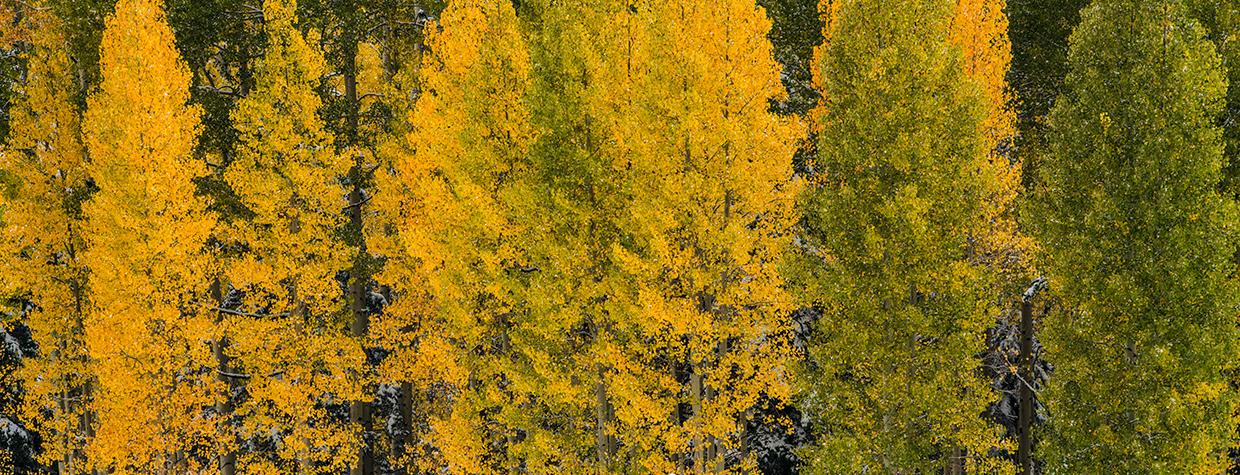Populous tremuloides. That’s their Latin name. In English, they’re known as “quaking aspens” — forest rangers and tree huggers like to call them “quakies.” No matter the name, there’s no mistaking a quaking aspen. Its smooth white bark is easily recognized in Arizona’s evergreen forests. The leaves are unique, too. Heart-shaped with finely saw-toothed margins, they attach to branches with a long and flattened petiole, so even the slightest breeze causes the leaves to flutter. That’s where the tree gets its name. And it’s the tree — or, rather, a forest of the trees — that gives this trail its name.
The hike begins at the same starting line as the Humphreys Trail, which is just a few hundred yards west of the Kachina Trail. Each of those trails is remarkable. And as a triumvirate, it might be the most impressive congregation in Arizona. Humphreys goes to the top of the state. Kachina goes to the base of the mountain. And the Aspen Loop, an easy stroll at about 9,300 feet above sea level, hovers in between.
From the trailhead, the route crosses a narrow, rocky meadow that’s punctuated by three of Arizona Snowbowl’s chairlifts. After about 100 yards, the trail splits — Humphreys continues west and the Aspen Loop veers south. As you make a slight descent toward the woods, you’ll catch a glimpse of Kendrick Peak in the distance. Then, after about five minutes of zigzagging, you’ll be out of the meadow and into the aspens — listen to them quaking as you enter their lair.
The trees, which come in all sizes, are often confused with birch trees. However, other than the color of their bark, they have very little in common. In fact, aspens are so unique, you could argue they’re not even trees at all. Instead, a stand of aspens is really a single organism where the main life force is underground. Think of aspens as part of an enormous root system that remains hidden below the surface until there’s enough sunlight to make the root system — known as an “aspen clone” — sprout up white organisms called trunks, which then give birth to green organisms called leaves. The clones vary in size and can live to be thousands of years old. The oldest and largest known clone, called Pando, is located in Central Utah. Scientists estimate it to be 80,000 years old, a number that makes the giant sequoias of the Sierra Nevada look like infants.
From the edge of the forest, a dirt path cuts through a bed of ferns, which spread across the floor like an assembly of lime-green lion’s mane jellyfish. The aspens are joined by spruce and firs, which help create an aviary for an assortment of birds, including flickers, jays, juncos and warblers. After 15 minutes of overall hiking, the trail dips out of the woods for a couple hundred yards before dropping back in. Where the trail re-enters the forest, the loop portion of the hike begins. Like all loops, you can approach this one from either direction. This listing runs clockwise, so turn left.
Initially, the trail makes a slight ascent before dropping back down again — overall, there’s very little elevation change on this hike. The drop continues for another five minutes until the trail enters another small meadow and arrives at an intersection with the San Francisco Peaks segment of the Arizona Trail. The elevation at the junction is 8,994 feet, which is the lowest point of the loop.
Keep right as the Aspen Loop overlaps the AZT for a short distance across a slope of more ferns to where the trails split again. It’s a quick ascent back to the point where the loop begins. After trekking in the open air of the meadow, the canopy of aspens offers a bit of refuge from the sun.
The trees have other attributes, too. According to scientists at Utah State University: “Aspens were a great source of food, medicine and wood for Native Americans. Many medicinal uses relied on the presence of salicin and populin, two precursors of aspirin that are present in all members of the genus Populus. Aspen bark had the most medicinal uses — preparations were used to treat ailments such as stomach pain, fevers and heart problems. The inner bark was considered a sweet treat for children, and it could be eaten raw, baked into cakes, or boiled into syrup and used as a spring tonic.”
Today, the tonic of the aspens is figurative. It’s what the Japanese call shinrin-yoku, or “forest bathing.” It’s the white against the green. And the sound of the leaves trembling in the wind.
trail guide
Length: 2.3 miles round-trip
Difficulty: Easy
Elevation: 9,295 to 8,994 feet
Trailhead GPS: N 35˚19.876', W 111˚42.695'
Directions: From Flagstaff, go northwest on U.S. Route 180 for 7 miles to Forest Road 516 (Snowbowl Road). Turn right onto FR 516 and continue 6.3 miles to the parking lot on the left. The trailhead is at the far end of the lot.
Vehicle Requirements: None
Dogs Allowed: Yes (on a leash)
Horses Allowed: No
USGS Map: Humphreys Peak
Information: Flagstaff Ranger District, 928-526-0866 or fs.usda.gov/coconino

